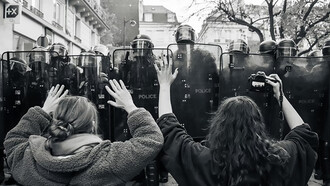Kamala Harris, as the Democratic candidate, faced notable criticism and resistance from the Black Community, more significantly than previous Democratic candidates. This response sparked some confusion. However, several factors help explain why such an unprecedented distance emerged between the Black Community and a Democratic candidate who is herself a Black woman. It is estimated that nearly 30% of Black voters who once pledged loyalty to the Democratic Party have shifted their support.
A subtle tool in Harris's campaign was the emphasis on neutrality. While this approach might be characterized as objectivity, it could also be described as indefinability, a lack of commitment to specific causes, or a fluidity of identity. This strategy could be seen as a cunning move, making her less vulnerable to Donald Trump's typical tactics of reducing opponents to stereotypes that end up overshadowing their overall political image.
However, this approach also revealed another consequence: Harris's ambiguous stance has rendered her more challenging to interpret, consequently making it harder for voters to relate to her on a personal or ideological level. This challenge is particularly pronounced when contrasted with figures such as Barack Obama, whose campaign was highly perceived by his racial identity and elevated by a quasi-prophetic leadership style. Obama’s candidacy resonated deeply with the electorate, largely due to his ability to embody a clear narrative of hope and social progress, a narrative intrinsically tied to his African American heritage and the broader struggle for civil rights. In contrast, Harris's more fluid and less defined public persona has not evoked the same level of connection or emotional investment from voters. Harris did not embrace or vocalize her African American heritage with the same conviction. This also casts doubt on the sincerity of her support for the struggles she has only lightly endorsed.
Kamala Harris’s past as a prosecutor in California has been a point of contention, particularly due to policies she supported that exacerbated prison overcrowding and disproportionately impacted Black communities. These policies contributed to systemic inequalities, with Black men bearing the brunt of the injustices within the criminal justice system. This history has left many questioning Harris’s commitment to address these disparities.
A further critique lies in her inconsistent approach to discussing her record. When engaging with Republican audiences, Harris frequently emphasized her prosecutorial achievements, portraying herself as a strong and objective enforcer of the law. However, when her past was scrutinized by Democratic voters or critics, she often sought to downplay or reframe her actions. This apparent shift in narrative, tailored to different audiences, created skepticism about her authenticity and accountability.
Her failure to address these controversies with clarity and conviction also led to perceptions that she took the support of African American voters for granted. By not offering a consistent or transparent account of her record, Harris may have alienated parts of the electorate who expected a more forthright acknowledgment of her past decisions and their consequences.
Many of these Black voters struggled to see Kamala Harris as a genuine and dependable representative of their interests, feeling that her approach reduced their community to a political tool, raising some thoughts about liberal racism in the Democratic Party. This perception undermined confidence in her ability to advocate authentically for meaningful change. In contrast, while Donald Trump was widely seen as an unsuitable representative for African American voters, his appeal for some lay in a kind of predictability: "better the devil you know than the devil you don't." For these individuals, Trump’s approach, though far from ideal, seemed more transparent than what they perceived as Harris’s inconsistent and instrumental engagement with their community.
Economic frustrations, coupled with a sense of political abandonment during the Biden-Harris administration, played a significant role in distancing the Black Community from the Democratic Party. Many felt neglected by the leadership that had long been associated with their interests, leading to a shift in allegiance and a weakening of their historical support for the Democrats.
Interestingly, this sense of abandonment found a complicated echo in Trump’s rhetoric, particularly his anti-immigration stance. Trump’s focus on prioritizing native-born citizens appeared to address concerns of some about job competition from illegal immigrants. This sentiment, though somewhat distorted, made Trump’s message appealing to those who felt sidelined in favor of other marginalized groups.
Alongside this, it is unsurprising that the Trump administration directs considerable attention toward the construction sector. This sector investment, which historically employs a substantial number of African American workers, was further aligned with the interests of many by prioritizing native-born labor since construction continues to be a vital industry for the African American workforce, reinforcing the significance of this focus.
As Trump’s presidency took shape, the initial appeal of his rhetoric began to wear thin, with the real consequences of his policies becoming evident to most African American voters. While some were drawn to his promises, others quickly recognized the contradictions and dangers in his administration’s approach. Despite reports highlighting that Trump did not select any Black individuals for his cabinet, even after capturing more African American votes than any other Republican, some voters argue that symbolic representation in the past has failed to deliver tangible results, leaving their expectations unmet. This reflects a divide within the Black Community.
On the other hand, some African American voters remain wary of Trump’s clear threats to their community, even when making a conscious effort to set aside his evident associations with white supremacist rhetoric. His policy proposals, however, appear fundamentally at odds with the progress many hoped for. For example:
Education: Trump’s proposal to eliminate the Department of Education under the guise of budget efficiency and ideological reform poses significant risks. Public school funding would be jeopardized, protections against racial discrimination could diminish, and critical topics such as race theory and slavery studies would likely be erased from curricula. This would disproportionately harm Black students, particularly those reliant on federal student loans, which would also be impacted by the department’s dissolution.
Economy: Trump’s economic policies, including tariff increases, would likely burden sectors such as food and retail, where many Black workers are employed. Moreover, his focus on tax cuts for the wealthy would increase the financial strain on middle- and lower-income households, exacerbating economic disparities.
Social Justice: Trump’s endorsement of measures like police immunity risks intensifying police brutality, which disproportionately affects Black communities. His open rejection of movements like Black Lives Matter, coupled with his refusal to acknowledge systemic racism, further alienates voters concerned with justice and equality. Policies undermining women’s reproductive rights and his disregard for structural inequality signal a broader neglect of marginalized groups.
Considering this analysis, while a Democratic administration might perpetuate the stagnation of systemic challenges faced by Black communities, another four years under Trump’s leadership would, at best, neglect their pressing needs. At worst, it risks reversing progress on crucial struggles for justice and equality, further entrenching social and economic disparities.















